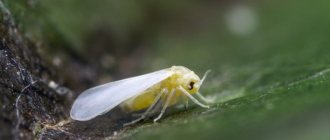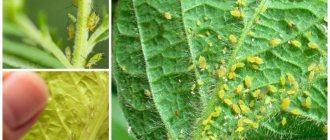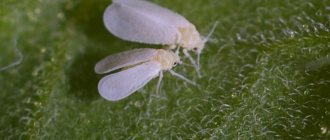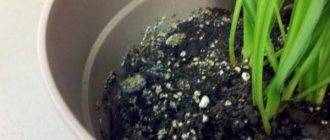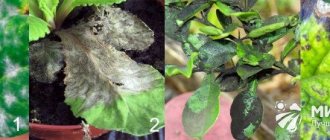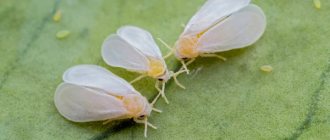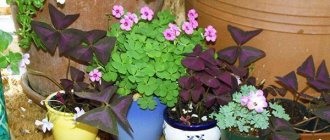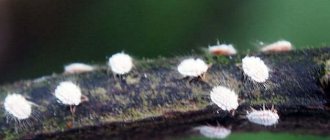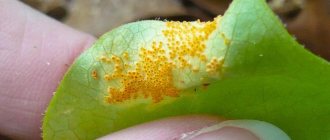White aphids are soft-bodied insects with a wide abdomen that damage house flowers. The size of the body together with the head does not exceed 1 mm, and the antennae can be twice as long. Aphids damage plants by sucking juice from leaves and young shoots. Individual insects are clearly visible to the naked eye; they are colored black, pink, yellowish or light green. With any number of aphids on indoor flowers, you can get rid of them in several ways.
What kind of insect is this and why is it dangerous?
An aphid is a white, drop-shaped insect, no more than half a centimeter in length. There are winged and wingless ones.
Winged aphids are capable of moving to other plants . Wingless insects reproduce massively. Aphids pierce leaves and suck out life-giving juices, taking away nutrients from the plant and creating pockets for bacterial infection (you can learn more about what aphids feed on in this material).
Where does it come from and what plants does it affect?
Typically, aphids come indoors on other plants. This could be a bouquet of cut flowers or a purchased infected flower. Sometimes an insect can fly into a room while airing.
To detect aphids, you need to examine the leaves and stem from the inside, where the females lay eggs. The larvae look like small white specks.
White aphids attack dicotyledonous plants; legumes are especially susceptible to attack. White aphids overwinter on pistachio trees .
Favorable conditions for the reproduction of pests are dry soil and high temperatures.
Early detection
You can understand that flowers are sick by their appearance - plants affected by aphids differ from healthy ones.
- The leaves are punctured and withering.
- White aphids have formed colonies.
- There is a sticky coating on all parts.
- Flowers fly around and change shape.
If you notice the signs, you should take action immediately.
Photo
Take a look at what the insect looks like in the photo:
How to get rid of pests on indoor flowers?
To combat aphids on indoor plants, both industrial preparations and folk remedies are used.
Chemicals
Fitoverm
A completely safe drug for humans, made from waste products of microorganisms. Fitoverm does not require removing plants from the premises .
It is necessary to dissolve 2 ml of the drug in 200 ml of water at room temperature. Pour the solution into a spray bottle and spray the flower thoroughly.
The biological product has a detrimental effect on pests, but does not accumulate in plant tissues. It acts both contactally when sprayed onto the surface of the body of insects, and when ingested through the intestines while eating treated plants.
After 10-15 hours, aphids lose their ability to feed. To consolidate the result, it is recommended to repeat the procedure after 5-7 days. Fitoverm works more effectively in a warm and dry room .
Aktara
This is a moderately dangerous product for humans; gloves must be worn when using the drug.
To prepare a solution, mix 8 g of the active substance with a liter of liquid. During processing, take the flowers out onto the balcony or street.
Aktar can be used when watering or spraying plants . The drug penetrates the body of insects, causing paralysis and death. After three weeks, you need to treat the flowers again to consolidate the result.
Aktara is addictive; the drug should be alternated with other insecticides.
We invite you to watch a video about how actara is used to combat aphids:
Aktellik
An effective product that begins to work when sprayed. Actellik kills aphids in one application .
Actellik is a non-systemic drug that acts only upon contact with insects and does not penetrate plant tissue. The effect of the product increases in warm conditions and high humidity.
For spraying, Actellik is diluted in a ratio of 2 ml per liter of water. Actellik is toxic and should not be sprayed in the presence of animals or children. It is necessary to wear gloves and a mask, carry out treatment only on the balcony or street and avoid contact with skin.
Homemade remedies
- Red pepper.
Pour 20 g of spices into 250 ml of boiled water. - Leave for 24 hours and boil.
- Cool the contents, strain and add soap.
- Soda and salt.
- For a liter of water you need 1 tablespoon of the product.
- Mix the mixture and spray the plant.
- Ammonia.
- Dissolve 5 ml of ammonia in a liter of water, stir, add soap.
- Spray the flower, leave for half an hour and rinse with water to avoid burns.
- Wood ash . Pour one glass of the ingredient into 5 liters of water, add 25 g of soap and leave the solution for a day.
- Cinnamon . Dilute a spoonful of cinnamon in a liter of water and treat the plant twice a day.
More information about traditional methods of combating aphids can be found here.
Life cycle of white aphid
Root aphids adapt surprisingly quickly to their environment and their life cycle can vary greatly depending on these conditions. insects reproduce asexually at any time during the growing season of the host plant. In the external environment, the eggs overwinter in the soil, and in the warm season or indoor conditions, they are attached to the leaves and stem above the root line, where they hatch and fall to the ground.
Aphids eat up the root of the plant, creating lesions that make the plant vulnerable to other conditions that are unacceptable to them - they dry out quickly without regular watering, and become unstable to powdery mildew and various diseases. As individuals within populations increase, aphids will gradually move up the stem to find more succulent areas to feed on.
Once the plant is mostly destroyed, some insects will develop wings that allow them to fly around in search of fresh plants. This pattern is especially active in closed greenhouses and greenhouses, where infection by root aphids affects all plants at once.
Pest control on orchids
Aphids are dangerous for orchids; they spread over the entire surface of the plant from the stem to the blooming flowers.
The insect is easy to detect by its white coating . It is necessary to check hidden places - the bases of shoots, buds, the underside of leaves.
Most often, aphids appear on orchids in a dehydrated room. Humidity should be maintained above 60%.
- You should regularly spray the leaves and stem with cool water, avoiding the accumulation of liquid in the flower, and fertilize the plant in a timely manner.
- An infected orchid must be immediately isolated from other indoor flowers, since aphids spread quickly.
- The simplest method of control is to thoroughly wash the flower and remove damaged parts.
The action of a soap solution is antiseptic for the plant and destructive for parasites.- Citrus infusion also helps fight the spread of aphids. To prepare it, you need to mix 100 g of lemon, orange or tangerine peels with a liter of boiling water and leave for three days. For greater effect, you can place the soaked peels on the ground.
- Aphids react poorly to essential oils. Suitable oils for treating orchids include tea tree oil, peppermint oil and neem oil. 30 drops of oil should be dissolved in 500 ml of water and applied to the plant with a sponge.
If these methods do not work, you should use chemicals. For orchids, Aktara, Fitoverm, Neoron, Fosfomit or Actellik are suitable.
You should not carry out more than three treatments with the same drug.
More details about how to fight aphids on orchids can be found in our article.
Prevention measures
Despite its apparent fragility, aphids are quite tenacious insects. It is easy to crush, but when there are several hundred insects, it will not be possible to destroy them all in this way. Until aphids appear on indoor flowers, it is better to fight with the help of prevention methods. If it is not possible to keep the purchased plant in quarantine, it is advisable to wash it with a solution of potassium soap or anti-flea shampoo, make sure that there are no signs of infection, and then place it with other flowers.
Ants should not be allowed to appear in a house or apartment. They raise and care for aphid colonies. Plants should be kept warm and clean. If the leaf turns yellow, it is better to cut it off immediately. The same should be done with dried branches. Any alarming symptom is a reason to examine the bush, and if necessary, treat it. It is better to throw away a copy that is almost completely eaten. Pity will lead to the miraculously surviving insects crawling onto healthy flowers.
Purchased pots and equipment must be disinfected. When you come from the garden, it is better to immediately change into clean clothes and send the clothes you take off to the wash, because they may have pests on them. It is enough to wash the shoes and wipe them from the inside. These are simple recommendations for protecting green pets from uninvited guests.
How to fight in the garden?
In the garden, aphids most often attack young shoots and buds . Leaves and stems affected by aphids have a sticky surface because the insects secrete an odorous mass - honeydew, which attracts ants.
- One way to control aphids in the garden is mechanical treatment. It is convenient to use a water hose for this. Using strong pressure, you can get rid of aphids and larvae by thoroughly washing the leaves. You should only remove parasites with your hands while wearing gloves.
- A safe method of killing aphids is the biological route. Ladybugs and lacewings are considered the best fighters among insects; you can buy several of them in a specialized store (read what other insects eat aphids here, and in this article we talked about how ladybugs help fight aphids). You can also attract birds to the garden using a bird feeder. Tits, linnets and sparrows can fight aphids.
- Proper planting helps prevent the appearance of aphids - insects are repelled by onions and garlic, as well as Dalmatian chamomile.
We invite you to watch a video on how to fight aphids in the garden:
Biological agents
Very often, if plants are moved from the room to the balcony, their owners use biological means of protection, attracting beneficial insects, including ladybugs, lacewings, and wasps. They eat aphids without harming plants.
Another way is to place plants next to your house flowers that will help get rid of white aphids on indoor crops. You can grow them yourself, or you can buy seedlings.
ladybugs
Dill attracts beneficial insects with its smell. Ladybugs are very fond of perennial cornflower, a flower that is considered a weed crop in wheat fields. Among garden crops, celery is considered such.
Tansy, dandelion, and cosmos flowers are also loved by ladybugs. Insects will not ignore yarrow, milkweed, fennel, and mint.
Lacewings
These insects may also be attracted to beneficial plants. Several types of mint, especially peppermint and catmint, are needed by lacewings. Cumin and nasturtiums attract winged insects with their strong scent.
Other insects
You can attract other insects that feed on white aphids to your open terrace or balcony.
These include:
- Ground beetles. Large black beetles from the order Coleoptera.
- Hoverflies. They are very similar in color to bees. They can transfer pollen from flower to flower.
- Rider. A beetle that looks like a thin wasp, but does not have a stinger.
When protecting plants, choose the most suitable means for you. And don’t forget to constantly inspect the flowers, which will help avoid many problems.
General preventive measures
For house plants:
Weak flowers are most susceptible to attack by parasites.- It is necessary to promptly remove dry leaves and yellowed stems.
- New flowers must be quarantined.
- Do not overfeed the plants.
- Be sure to get rid of ants and choose planting sites with diffused light.
- Before planting in a new pot, the flower must be sterilized.
- Twice a week, inspect all plants in the house and regularly rinse them with running water.
For garden flowers:
- Systematically remove weeds.
- During the summer, destroy anthills. This must be done, since ants protect aphids in every possible way and even bring them into the garden themselves (read more about the symbiosis of these insects here).
- In the spring, carry out sanitary pruning of all plants.
- Before buds begin to bloom, spray fruit trees and flower stems with insect repellent.
- Do not overfeed plants with nitrogen.
- Wash plants with a hose.
Who is the white or root aphid?
Root aphids are one of the types of pests that can most often be found at or slightly above the soil line, since their life cycle is associated with this environment. Since this species also feeds mainly in the root part of the plant, which is poor in chlorophyll, the body color of the pest is predominantly white, although in some cases it can turn into green shades.
Root aphids are quite a strong pest, especially among indoor plants, since they are most easily introduced with soil, and the feeding process occurs at the very root. If the ordinary green aphid destroys those parts of the plant that are located at or above the level of its largest population, then the white aphid spoils the base of the stem, thereby disrupting the normal processes of growth and nutrition of the entire plant.
In addition, white aphids are much more difficult to detect, unlike small colonies of green and other aphids that can be found “live” on stems and leaves. Root aphids hide in the soil more successfully, reproduce more prolificly and move much faster. As a result, her colonies will be virtually invisible, despite the fact that her colonies will suck up enough of the plant's sap that the plant will begin to show irreversible changes and even die before the cause becomes clear.
Upon close inspection of the plant, you will often find a white, waxy material secreted by root aphids. There is especially a lot of this peculiar honeydew at the base of the stem and the first few millimeters of the root down from the soil line.
If a living individual catches your eye, you can note the following external characteristics - the body of the insect is more pear-shaped than that of green aphids, but somewhat smaller, and the insects themselves move more actively. Many people confuse white aphids with mealybugs, and for good reason, because they have quite a lot in common, but the latter have a more oval-shaped body. Root aphids are about the same size or slightly smaller than green aphids, but have shorter legs and antennae. Also, an interesting fact is that this type of pest comes in a variety of colors, including pink, but they are mostly white and brown.
Besides mealybugs, due to their unusual color and winged stage, white aphids are often confused with fungus gnats. The main differences in this are the characteristics that all aphids have - a small tail extension at the end of the abdominal cavity, which also distinguishes them from mealybugs.
Because of their size and habitat below the soil line, root aphids can go undetected, even after one or even several complete biological cycles. In addition, their damage is often mistaken for other problems, especially nutritional deficiencies. Such traces of insect activity are similar to magnesium or iron deficiency, so when such signs appear, flower pots should be carefully checked for the presence of root aphids.
House flowers are not the only hosts of root aphids. There are also quite a lot of them in open ground, where the pest activity of insects is traditionally accompanied by the activity of ants and similar signs of plant damage.
